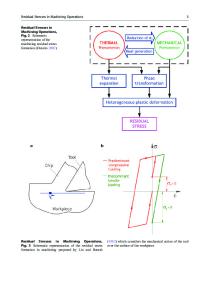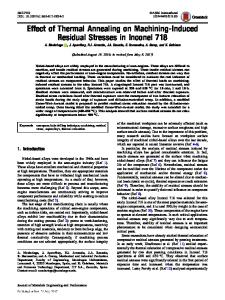Effect of Pulse Current on Residual Stresses in AMg6 Aluminum Alloy in Electrodynamic Treatment
- PDF / 659,615 Bytes
- 7 Pages / 594 x 792 pts Page_size
- 89 Downloads / 320 Views
EFFECT OF PULSE CURRENT ON RESIDUAL STRESSES IN AMg6 ALUMINUM ALLOY IN ELECTRODYNAMIC TREATMENT Yu. M. Sydorenko,a M. O. Pashchyn,b,1 O. L. Mykhodui,b b
Yu. A. Khokhlova, and M. A. Khokhlov
UDC 539.3; 537.39
b
The development of energy-efficient methods of controlling the stress state of metallic materials and welded joints is topical for modern production. One of such methods is electrodynamic treatment (EDT). It is based on the passage of electric current pulses (ECP) through the metal, time-synchronized with an impact load initiated by electrodynamic forces. In this case, an electrodynamic deformation process and a process of formation of elastic strain waves occur simultaneously in the material being treated; they are defined as “electrodynamic impact”, the result of which is a local stress relaxation in the metal. The developed mathematical model of the formation of stress and strain fields during EDT, which is based on the motion of an elastoplastic medium, does not take into account the effect of ECPs on dynamic relaxation processes. A computational and experimental assessment of the effect of ECPs, which is based on the experimental assessment of the stress state and microindentation of AMg6 aluminum alloy plates after EDT without and with the passage of ECPs through the metal being treated, has been performed by the mathematical modeling of the EDT process taking into account microindentation results. The passage of ECPs contributes to an increase in tensile plastic strains and hence to an increase in residual compressive stresses (provided that the specimens to be treated are rigidly fixed). The reliability of the procedure has been confirmed by the results of evaluating the distribution of residual welding stresses in AMg6 alloy butt joints after EDT. Keywords: electrodynamic treatment, aluminum alloy, electric current pulse, impact load, discharge circuit, microindentation, electroplastic deformation, residual stresses, continual model, elastoplastic medium, finite element mesh. Introduction. The EDT of welded joints and structures by the action of pulsed electromagnetic fields is used to reduce the level of residual stresses in products made of light alloys in aircraft and shipbuilding [1, 2]. The EDT mechanism is based on the joint influence of an electric pulse current (EPC) and an impact load P on the welded joint by means of the contact of the working electrode with the metal surface at the instant of discharge of capacity storage. In this case, processes of electroplastic deformation [3] and the formation of elastic strain waves, which are defined as “electrodynamic impact,” occur simultaneously in the material being treated. The result of this operation is a local stress relaxation in the metal. The developed mathematical model of the formation of stresses and strains during EDT [4], which is based on the motion of an elastoplastic medium, does not take into account the effect of EPC. At the same time, the results of an experimental study of the separate effect of EPC and impact load during E
Data Loading...











